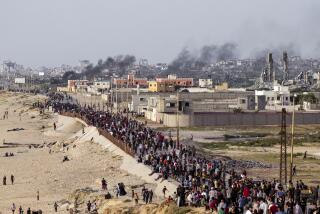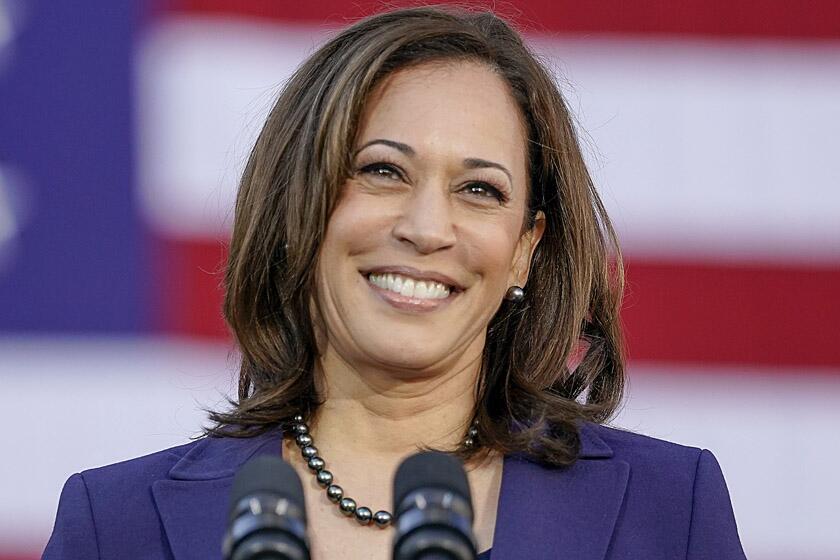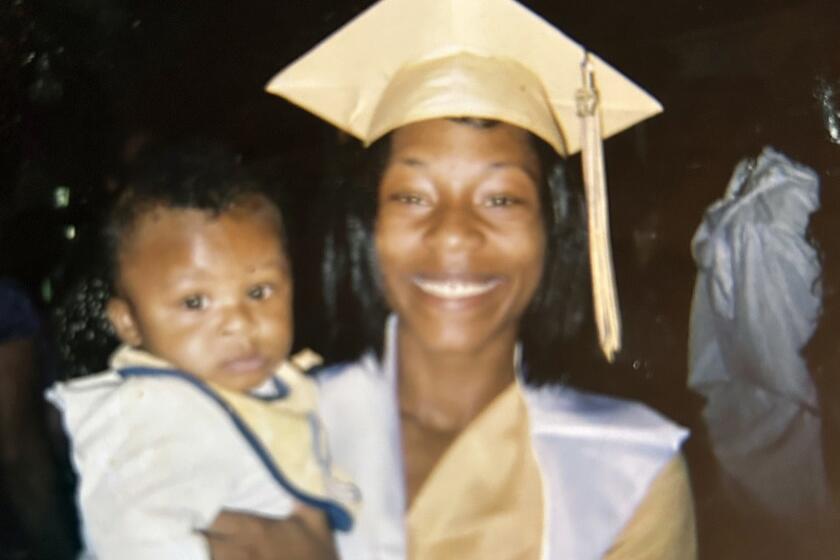‘Even the Pigs Have Something to Say’
The Pigs of 1968 are out in force again. On country club greens and in catering halls, Irish pubs and inside a museum that houses one man’s crusade to restore the blighted name of the Chicago Police Department, the graying cops who clubbed young demonstrators during the chaotic Democratic National Convention are looking back in anger.
As their city prepares to host its first national political convention since the debacle of ‘68, police veterans who took to the streets that year are honing old war stories as they gather at retirement luncheons and golf outings. Still unruffled by guilt, they bemoan only their lost honor, the ignominious tag of “police riot” that tarnished their handling of the bloody weeklong clashes with Vietnam War protesters.
“Our side of the story never got told,” said Joe Pecoraro, a retired officer who was in the thick of the scuffles. “We were the Pigs, right? Well, even the Pigs have something to say.”
Pecoraro is the founder of the American Police Center and Museum, a converted brick warehouse strewn with thousands of relics from the department’s private history. He built his shrine to counter the brutal image that has dogged his generation of officers since the 1968 convention--when police swept through downtown parks and streets, clubbing and arresting scores of antiwar demonstrators, reporters and onlookers over a week of clashes decried as rampant brutality by the press and the Walker Report, a federal panel convened to investigate the department’s conduct.
These days, Pecoraro oversees preparations for a museum exhibit on that tumult, confident this summer is ripe to tell “our point of view” to visiting schoolchildren and conventioneers.
Even after a generation of reforms that have transformed the department, the persistence of memory still rankles older veterans. The gnawing sense that unfinished business remains from the convention offers a cautionary hint of the long road facing any police agency trying to heal deep institutional scars--just as the Rodney G. King case continues to vex Los Angeles’ police.
“It’s fair to say what happened in 1968 is still important to us now,” said Matt Rodriguez, who as a young officer was pummeled by protesters while he supervised arrests amid the stampedes on Michigan Avenue. “What older officers are saying is, ‘If you only knew what we went through.’ ”
Now superintendent of Chicago’s 13,200-officer force, the 60-year-old Rodriguez sees this coming convention as a moment of redemption. He bridles at shallow comparisons between his force and 1968’s, but recognizes the importance of symbols. If the whole world is watching this August, a cool, measured performance by his officers might lift the department’s stigma, Rodriguez believes.
“It would be,” he said, “a nice way of putting those ghosts to bed.”
Six blocks from police headquarters, Pecoraro has his own ideas for exorcising the ghosts. His museum staff is putting the finishing touches on the display that will show the ’68 convention from the cops’ point of view.
Snapshot of an Era
Pecoraro has assembled a trove of photographs and literature from the convention. There are copies of inflammatory leaflets passed out by Yippies, the antiwar protesters who used street theater and the vocabulary of outrage to get under the skin of police and city officials. There are photos showing weapons seized by police: chunks of concrete, baseball bats, bent nails, spiked whiffle balls, even a bottled black widow spider taken from a demonstrator who claimed he had tossed arachnids at police.
“Read through this display,” a caption announces, “and see for yourself the difficulties police officers faced during that ‘shocking convention.’ ”
“Not bad,” Pecoraro said, strolling past walls lined with police medals, billy clubs and vintage machine guns. “And wait’ll you hear the crowning touch. We’ll have two mannequins on either side of the display. One’ll be dressed up like a cop, 1968 uniform, riot helmet, club, the whole thing. And the other will be dressed just like a Yippie. You know, sunglasses, poncho, tie-dye shirt. Maybe I’ll have him throwing a brick.”
Pecoraro was among the hundreds of officers ordered by Mayor Richard J. Daley to clamp down on protesters gathering by the thousands in Grant and Lincoln parks, the two downtown green spaces, and in streets near delegates’ hotels.
Told to keep protesters out of the parks and away from the convention hall, police clashed repeatedly with the growing mobs. The violence built until the night of the convention’s nominating speeches, when news crews aired live broadcasts of the chaos outside the Hilton hotel. Police roamed the streets, lashing out at demonstrators, who responded with barrages of debris.
The violence led to 668 arrests and about 1,000 injuries--nearly 200 reported by police and 800 reported by hospitals and medical teams set up by demonstrators.
Pecoraro says he will not gloss over evidence that police clubbed and beat demonstrators. But he wants museum visitors to understand the police culture of 28 years ago--why the officers felt compelled to use force as they did.
“We were told over and over in training and around the station houses that you meet force with stronger force,” Pecoraro said. “You take a swing at us, we were supposed to hit back--and harder.”
A Different Force
Although the use of force is still an essential part of Chicago police training, officers readying for this year’s convention have a broader array of options before taking out their batons--from “verbal judo” to summoning horse-mounted officers.
“This generation of officers,” Rodriguez said, “is more apt to think for themselves.”
A majority of his officers are college-trained. More than a third are black or Latino, 10% are women--compared to a 1968 force that was 99% male and overwhelmingly white. Time itself has distanced the department from the 1968 generation--its youngest officers were not born when cops and Yippies faced off in the band shell at Grant Park, where antiwar leaders Abbie Hoffman, Tom Hayden and Jerry Rubin gathered for speeches and where the most violent police sweeps occurred.
Chicago police have had their share of controversies in recent years--torture allegations at an inner-city station house, the fatal shooting of an unarmed homeless man by an off-duty officer, the firing of officers linked to street gangs. But the department has capably managed a spate of crises, keeping the peace at 1994 World Cup soccer games and preventing full-scale riots after street violence during four 1990s Chicago Bulls championship celebrations.
When the Bulls won the NBA title in June, Rodriguez flooded the streets with 6,000 officers in what seemed like a dry run for August. Looting damage and arrests were minimal. And despite a rash of shootings, there were few injuries and no deaths. Even with the department’s massive mobilization, there was no evidence of police brutality.
In training for this convention, younger cops are being given a surprisingly unflinching look at 1968’s chaos. About 2,500 tactical and patrol officers assigned to front-line duty this summer are watching screenings of a public television documentary on 1968 and listening to warnings and tactical tips from veterans of that era.
To many young officers unfamiliar with the earlier convention, listening to old-timers’ battle tales and viewing dated film clips is a little like watching old military footage. It is someone else’s war.
“The younger guys don’t talk about it, don’t worry about it,” a North Side patrolman said bluntly. “We’ll do fine. It’s only the older generation that tears their hair out over this stuff.”
‘We Got a Bum Rap’
The graying police warriors are familiar with that blithe confidence. They had it once themselves. But as this year’s convention approaches, many veterans are growing defensive, convinced they will be damned again. Soon enough, they complain, the tide of old films and photographs will start rolling--and each glimpse of a helmeted cop cracking down on an unarmed demonstrator will perpetuate their villainy.
“We got a bum rap then and we’re getting it now,” said Lou Cantone, 72, a retired 34-year veteran who worked with Rodriguez as an organized-crime detective in 1968. “There was no police riot. We were in the middle of a battle, and we battled back. We didn’t provoke it, but we didn’t back down, either.”
There are nearly 900 veterans of 1968 still on the force, barely 7% of the department’s manpower. Many are ranking officers and detectives in their 50s and 60s who have recast themselves--as Rodriguez has--in the ultra-professional mold of 1990s-era policing.
With the hindsight of the converted, some of those veterans now acknowledge that training and command errors made by an over-confident police hierarchy contributed to the anarchy in the streets. Senior department officials went over the training that police underwent in 1968 to determine what went wrong--and to figure out what training younger officers needed, Rodriguez said.
“There just wasn’t enough supervision out there,” said Det. Paul Seiler, 52, who was doused five times by tear gas mistakenly lobbed by National Guard soldiers.
Commanders wore the same uniforms as patrolmen, making them hard to recognize in crowds. Walkie-talkies were rare, adding to the confusion. Few patrolmen were trained properly to use their batons as prods, and they resorted to wild swings as they moved into the crowds.
Despite ample anecdotal and visual evidence that officers “ranged the streets striking anyone they could catch,” according to the Walker Report on convention violence, few police veterans talk candidly about exacting “street justice.”
One who does is Art Balla, an artistic engraver who worked as a police evidence photographer during the convention. As he snapped shots of demonstrators near Grant Park, a concrete chunk struck him in the mouth. Spitting out blood and two broken teeth, Balla “saw stars” for several minutes.
“I didn’t know who threw it, but I saw a bunch of guys throwing stuff, so I went over there with some other officers and we caught some of these guys,” Balla recalled.
Despite the fact that the man he attacked may not have been the one who threw the concrete, Balla feels justified all these years later. “Maybe it wasn’t the guy who hit me, but it was close enough,” he said. “He deserved it.”
Most veterans describe their use of force as a reaction to debris rained on them by demonstrators. Some tell of being targeted by plastic bags filled with feces--tales that historians now debunk.
David Farber, a Barnard College history professor and author of “Chicago ‘68”--the most exhaustive account of the convention--said his research showed that “violence definitely was started by police.” Protesters retaliated with rocks by the second day, he said. But despite police claims, he found no evidence that feces were hurled at police.
If police claims of attacks by demonstrators were exaggerated, why did they resort to violence? Some veterans blame it on simple fear. They describe their actions the way retired patrolman Eddie Collins does--swinging their batons for protection as they approached the surging crowds.
Collins, 65, was among the officers who moved in on protesters at Grant Park. “As you went in, you didn’t want the police on either side of you to know how scared you were,” said Collins, who feared being trampled. “You just looked straight ahead. I used my baton plenty.”
Living With Fear
He said he used the baton as he had been trained, as a two-handed prod to move demonstrators. Around him, he recalls, he saw patrolmen swinging the clubs like baseball bats. “Other guys, my guess is, they were even more scared than I was, and they just lost it.”
The fears welled up each day he went out into the crowds, Collins said. Sleeping was difficult when he returned home. Each night, he gulped Scotch and smoked a half-pack of cigarettes. “Who could sleep when you knew you had to go out the next night and go through all that crap all over again?”
But whether scared or unafraid, police veterans of the 1968 convention are unified in their belief that the demonstrators should bear the blame for the violence.
“We didn’t do much soul-searching then and we’re not doing it much now,” said Jerry Gladden, 62, a retired member of the department’s intelligence unit, the “Red Squad.” “We felt we did a good job because we didn’t kill anybody.”
Now an investigator with the Chicago Crime Commission, Gladden said that many “coppers kind of liked the reputation we got afterward, of being tough. We stood up to these kids, you know. Among cops, we were heroes.”
One recent Thursday, Gladden and 40 veteran officers crowded into O’Malley’s, a pub on the city’s South Side. They came as members of the Mystic Order of Secret Stuff, a group of some of the most experienced detectives. The club meets once a month to swap tales and catch up on gossip about a department that seems increasingly alien to them.
At one table, a group of retirees sized up a pile of T-shirts that have become wildly popular among cops here. The front has the department’s five-point badge. The back reads: “In 1968, we kicked your father’s ass. Wait’ll you see what we do to you.”
Jostling around steam trays piled high with corned beef and cabbage, the veterans of ’68 took turns venting their anger at a world that has been against them for three decades--federal officials, the media, historians and the surviving Yippies and activists who plan return pilgrimages this August.
“They all made us out like we were the Gestapo,” said Det. Ellwood Egan, then a homicide investigator and now a police liaison with the FBI. “We heard it from the media, the Walker Commission, all the Monday-morning quarterbacks.”
The fact that commission director Daniel Walker later was elected Illinois governor, only to be convicted in 1987 of federal bank fraud, fuels their cynicism.
“The Walker Report [of the ’68 convention] was the final straw for me,” Pecoraro said. “That’s when I decided we had to do something to get our reputation back.”
‘It’s History Now’
Realizing there was no place within the department where citizens could “see what police go through,” he decided a museum “was the best thing to tell our story.”
In 1970, after he was elected president of the Chicago Patrolman’s Assn., he finally had the means to fulfill his dream. He began writing to the group’s 1,900 members, seeking financial backing. In came $12,000--enough to rent a second-story walk-up near department headquarters.
Since 1986, when he retired, Pecoraro has given the association and its museum his full attention.
Moving to larger quarters on State Street, his new museum is crammed with thousands of artifacts donated by Chicago cops to justify their work--a rogue’s gallery photo display of Al Capone and other criminals, garish morgue exhibits, blinking traffic signs, a squawking police radio, wreaths dedicated to fallen comrades.
But the crowning glory will be the 1968 convention display, the driving force behind the American Police Center and Museum’s existence--and Pecoraro’s obsession.
“My attitude is, it’s history now,” he said, looking over the display one more time. “Look at it, try to understand it, but it’s history; it’s done. If there’s any moral, it’s this: Let’s remember not to come to this city and make trouble. OK?”
More to Read
Sign up for Essential California
The most important California stories and recommendations in your inbox every morning.
You may occasionally receive promotional content from the Los Angeles Times.






